Beobachtungen:
SEUMS-vier
Subtile Effekte Universelles Measuring System SEUMS
Protokolle der Versuche seums.htm seums-zwei.htm seums-drei.htm
Kurzfassung, Extrakt
Mit dieser Mess-Anordnung wird eine Information über die Intensität eines Objektes (analoger Wert) in einen Winkel (analoger Wert) umgewandelt. Das Ergebnis beruht lediglich auf einer Ja/Nein-Information (digital): "Bis hier reicht die Struktur, dahinter ist sie nicht vorhanden."
With this measuring arrangement an information about the intensity of an object
(analog value) is converted into an angle (analog value). The result is based only on a yes/no information (digital): "Up to here the structure reaches, behind it it is not present." |
Meßbare Größen
- Spannung
- Strom
- Temperatur
- Kraft
- Durchfluß
- Drehzahl
- Abstand
- Winkel
- Magnetfeld
- Sonnenlicht
Mögliche Detektoren
glatte parallele Flächen, exakt in Richtung Nord-Süd ausgerichtet,
reagiert schon auf kleinste Winkelabweichungen von wenigen Grad und wird bei zu großen Abweichungen unempfindlich,
Flächen möglichst mit abgerundeten Kanten (strömungsgünstig)
- ein Graphitwürfel
- zwei Aluminiumbleche als "Doppeldecker"
- ein Aluminiumblech
- ein Kupferblech
- eine Glasscheibe
- ein Küchenbrett aus Plastik
- eine kupferkaschierte Leiterplatine (Flachspule)
Anregungen
- aus Nord (vermutlich Teilchen, angetrieben durch Zentrifugalkraft der Erde)
- aus Ost (vermutlich Teilchen), "Gegenwind" bei der Erdrotation
Einsatzmöglichkeiten
Mit dem SEUMS lassen sich die Eigenschaften von zusätzlichen Anregern quantitativ ermitteln.
Sie können in den Hauptrichtungen Ost oder West, d.h. von der Seite oder auch schräg auf den Detektor "strahlen" .
- konische Körper
- Permanentmagnet
- Batterie
- aktive Körper
- Stab
- Rohr
- Pflanze
- Papierrolle, Drahtrolle
- Leiterschleife
- mentaler Pfad
- Entstörer, "Harmonisierer"
- gespannte Feder
- Sonnenlichtbündel
- Lärm, laute Arbeitsmaschine, Hubschrauber
- "Temperaturstrahlung" von erwärmten Körpern
- rotierender Körper
- elektrische Geräte, Mobilfunk, Elektrosmog durch Funkwellen, wechselnde Magnetfelder
- Abschirmmaterialien
Skala
Mit dem System lassen sich Intensitäten der Anreger in einen Winkel umwandeln.
Dieser kann als geometrisch erfassbare Längen an einem Meßkreis (z.B. als Öffnungswinkel von spürbaren Strukturen in den
beiden südlichen Quadranten) abgelesen werden und maximal einen Viertelkreis für jeden Quadranten ausfüllen.
Die zugehörige Skala ist gewissen Bereich nahezu linear.
Veränderung des Meßbereichs
Der Abstand zwischen Anreger und Detektor bestimmt, wie empfindlich das System reagiert. Starke Anreger sind weit entfernt
zu plazieren, schwächere dichter dran, damit der "Anzeigewert" im Winkelbereich von ca. 20° bis 80° liegt.
Vergleichsmethode
Wenn es keine Kalibrierung der Skala gibt, empfiehlt es sich, Objekte in ihrer Wirkung miteinander zu vergleichen.
Dazu wählt man auf der Skala einen festen Wert aus z.B. 30° und verschiebt die zu vergleichenden Meßobjekte einzeln so
auf der O-W-Achse hin und her, bis die Anzeige diesen Wert erreicht hat. Dann geben die zugehörigen Abstände zwischen
Detektor und Meßobjekt ein relatives Maß ab.
Kalibrierung
Wenn der Zusammenhang zwischen Intensität und z.B. zwischen der Anzahl von gleichartigen Anregern oder der wirkenden
Fläche des Anregers linear (oder irgend wie anders) bekannt ist, empfiehlt sich eine Meßreihe mit unterschiedlichen Anzahlen
oder verschieden großen Flächen. Damit ist anschließend eine mathematische Umrechnung der Skala möglich.
Ergebnisse beim Arbeiten mit SEUMS
- Die geografische Nord-Südrichtung (nicht die Kompass-Richtung) und die geografische Breite lassen sich bis auf weniger als zwei Grad genau bestimmen. beschleunigte-ladungen.htm#kapitel-05 seums-zwei.htm#kapitel-01
- Neben der Anregung aus dem Norden (Zentrifugalkraft der Erde) gibt es eine weitere Anregung aus Osten.
Dieser "Ostwind" beinflußt z.B. die spürbaren Strukturen von aktiven Körpern.- Dies folgt aus dem Verhalten von Rahmenspulen, bei denen die effektive Fläche in O-W-Richtung proportional zum Einfluß auf den Detektor ist. Sie wirkt dabei wie eine Peilantenne. seums-drei.htm#kapitel-04-01
- Mit Hilfe von speziellen Toroidspulen läßt sich zeigen, daß diese Anregung rotierende Komponenten enthalten muß.
seums-drei.htm#kapitel-06-02 - Bei
biologischen aktiven Körpern wie z.B. Holzstäbe, Gemüsegurken usw. ist
die Länge der spürbaren Struktur an der Spitze bei Ausrichtung nach
Osten sehr viel kleiner als bei Ausrichtung nach Westen. Es muß daher so
etwas wie einen "Gegenwind" vorhanden sein. seums-drei.htm#kapitel-08-02
- Dies gilt auch für andere aktive Körper seums-drei.htm#kapitel-06-01
- Beide
Anregungen lassen sich mit Hilfe von "Abschirmmaterialien" selektiv
ausschalten, die man entweder auf der Ost- oder auf der Nordseite vor
dem Detektor aufstellt. Das Aufstellen auf den Gegenseiten des
Detektors hat keine Abschirmwirkung.
seums-drei.htm#kapitel-09
- Dies folgt aus dem Verhalten von Rahmenspulen, bei denen die effektive Fläche in O-W-Richtung proportional zum Einfluß auf den Detektor ist. Sie wirkt dabei wie eine Peilantenne. seums-drei.htm#kapitel-04-01
- Es
muß mehr als nur eine Sorte von Magnetfeld geben. Unterschiedliche
Magnete z.B. Ferrit, Neodym oder Elektromagnet lassen sich in ihrer
Wirkung mit SEUMS unterscheiden, wenn man sie mit Aluminiumfolie oder
anderen Materialien "abschirmt".
seums-drei.htm#kapitel-05 konische-koerper-kurz.htm#04-03-05 - Aktive
Körper verlieren ihre Intensität drastisch, wenn man sie mit Wismut
oder Antimon (sehr starken Diagmagneten) "abgerieben" hat. Meist lassen
sie sich jedoch reaktivieren durch Berühren mit beiden Händen oder
ausgewählten Gegenständen.
wismut.htm beschleunigte-ladungen.htm#kapitel-09-03 - Elektrische
Leiterschleifen erfahren eine Anregung von außen (z.B. "Ostwind"). Die
mit SEUMS meßbare Intensität läßt sich durch "Belastung" mit einem
ohmschen Widerstand verringern. Somit läßt sich ein Testobjekt mit
definierten Eigenschaft erstellen. Auch bei "Belastung" mit einem
Kondensator verändert sich die gemessene Intensität. seums-drei.htm#kapitel-03
- Elektrische
Leiterschleifen können als "Abschirmung" wirken, d.h. sie behindern je
nach Belastung durch einen Widerstand den Durchgang eines "Strahls". Es
könnte sich also beim "Ostwind" um magnetische Elemente handeln, die in
der Leiterschleife eine Spannung induzieren. Fließt dann über den
Widerstand ein Strom, müßten diese
Elemente Energie abgeben und deswegen langsamer werden (d.h. für nachfolgende
einen "Stau" erzeugen und weniger pro Zeiteinheit durchlassen). Solch abbremsendes Verhalten findet man auch anderswo,
z.B. wenn ein Stabmagnet durch ein Kupferrohr herabfällt.
seums-drei.htm#kapitel-03 - Bei
einer Flachspule als Detektor scheint es eine Resonanz zu geben, wenn
sie mit einem geeigneten Widerstand belastet wird. Bei passender Größe
nimmt die Empfindlichkeit resonanzartig zu. seums-drei.htm#kapitel-02-02
- Unterschiedliche
Materialen beim Detektor wie Kupfer oder Aluminium erzeugen spürbare
Strukturen mit verschiedenen Qualtitäten. seums-zwei.htm#kapitel-01
- Wenn
ein Kunststoffrohr exakt in der Richtung der Zentrifugalkraft
orientiert ist, entstehen im Rohr Wellen, die sich auch über Krümmungen
wie in einem Wellenleiter ausbreiten. Mit Hilfe von am Rohr angelegten
magnetischen oder elektrischen Wechselfeldern lassen sich Resonanzen bei
13.6 Hz mit vielen Harmonischen beobachten.
Setzt man ein Vakuumgefäß vor den Eintritt des Rohres, verhindert es die Entstehung der Wellen am Rohrausgang nicht (d.h. die Anregung müßte über Teilchen erfolgen). Jedoch ein Vakuumgefäß am Austritt des Rohres unterbricht die Ausbreitung der Strukturen ( d.h. der Wellen). beschleunigte-ladungen.htm#kapitel-07
Noch nachzuprüfen: Vakuumgefäß wirkt wie eine Diode (konischer Körper?). Dreht man es um, ist der Einfluß genau umgekehrt. ... - Bei Beugungsexperimenten mit Stäben und Drahtgittern ergeben sich Wellenlängen im Bereich von Millimetern.
beschleunigte-ladungen.htm#kapitel-05-01 - Es gibt einen Teilchenstrom, der sich mit elektrischen und magnetischen Feldern ablenken läßt bei
- Halbleiterdiode konische-koerper.htm#kapitel-04-01a
- konischem Körper konische-koerper-kurz.htm#04-03-01b
- elektrischem Dipol beschleunigte-ladungen.htm#dipol-bremsstrahlung
- Sonnenlicht
besteht neben dem sichtbaren aus einem weiteren, spürbaren Anteil, der
sich mit elektrischen, magnetischen Feldern oder mit rotierenden
Objekten ablenken läßt. licht-experimente.htm#kapitel-05
Die Intensität eines Lichtbündels läßt sich mit dem SEUMS bestimmen. seums.htm#kapitel-03-08 - Bei einem Dipol treten bei Wechselstrom geladene Teilchen aus, die sich mit einem elektrischen Feld ablenken lassen.
Mit zunehmender Wechselspannung oder Frequenz nimmt der Ablenkwinkel bei gleicher Ablenkspannung ab.
beschleunigte-ladungen.htm#dipol-bremsstrahlung
Measurable quantities
- Voltage
- Current
- Temperature
- Force
- Flow rate
- Speed
- Distance
- Angle
- Magnetic field
- Sunlight
Possible detectors
smooth parallel surfaces, exactly aligned in north-south direction,
reacts already to smallest angle deviations of a few degrees and becomes insensitive at too large deviations,
surfaces with rounded edges if possible (streamlined)
- one graphite cube
- two aluminum sheets as "biplanes
- one aluminum sheet
- one copper sheet
- a pane of glass
- a plastic kitchen board
- a copper-clad printed circuit board (flat coil)
Excitations
from north (probably particles, driven by centrifugal force of earth)
from the east (presumably particles), "headwind" from the earth's rotation
Possible applications
With the SEUMS the properties of additional excitations can be determined quantitatively.
They can "radiate" in the main directions east or west, i.e. from the side or also obliquely onto the detector .
- conical bodies
- permanent magnet
- battery
- active bodies
rod
tube
plant
paper roll, wire roll
conductor loop
mental path
suppressor, "harmonizer - tense spring
- sunlight beam
- noise, loud working machine, helicopter
- "temperature radiation" of heated bodies
- rotating body
- electrical devices, mobile radio, electrosmog by radio waves, changing magnetic fields
- shielding materials
Scale
With the system intensities of the exciters can be converted into an angle.
This can be read off as geometrically detectable lengths on a measuring circle (e.g. as the opening
angle of perceptible structures in the two southern quadrants) and fill a maximum of one quarter circle for each quadrant.
The associated scale is certain range almost linear.
Change of the measuring range
The distance between exciter and detector determines how sensitive the system responds.
Strong exciters are to be placed far away and weaker ones closer, so that the "display value" lies
in the angular range of approx. 20° to 80°.
Comparison method
If there is no calibration of the scale, it is recommended to compare objects in their effect.
To do this, select a fixed value on the scale, e.g. 30°, and move the measuring objects to be compared
individually in the following way to and fro on the O-W axis until the display has reached this value.
Then the corresponding distances between detector and measuring object give a relative measure.
Calibration
If the relation between intensity and e.g. between the number of similar exciters or the effective
area of the exciter is known linearly (or in any other way), it is recommended to perform a series of
measurements with different numbers or areas of different size. This allows a mathematical
conversion of the scale afterwards.
Results when working with SEUMS
The geographic north-south direction (not the compass direction) and the geographic latitude can be determined
accurately to less than two degrees. beschleunigte-ladungen.htm#kapitel-05 seums-zwei.htm#kapitel-01
Beside the excitation from the north (centrifugal force of the earth) there is another excitation from the east.
This "east wind" influences e.g. the noticeable structures of active bodies.
This follows from the behavior of frame coils, where the effective area in the E-W direction is
proportional to the influence on the detector. It acts like a DF antenna. seums-drei.htm#kapitel-04-01
With the help of special toroidal coils it can be shown that this excitation must contain rotating components.
seums-drei.htm#kapitel-06-02
In biological active bodies such as wooden sticks, vegetable cucumbers, etc., the length of the perceptible
structure at the tip is much smaller when oriented to the east than when oriented to the west.
Therefore, there must be something like a "headwind." seums-drei.htm#kapitel-08-02
This is also true for other active bodies seums-drei.htm#kapitel-06-01
Both of these excitations can be selectively eliminated by using "shielding materials" which are placed in
front of the detector on either the east or north side. Placing them on the opposite sides of the detector
has no shielding effect. seums-drei.htm#kapitel-09
There must be more than one kind of magnetic field. Different magnets e.g. ferrite, neodymium or
electromagnet can be distinguished in their effect with SEUMS if they are "shielded" with aluminum foil or other materials.
seums-drei.htm#kapitel-05 konische-koerper-kurz.htm#04-03-05
Active bodies lose their intensity drastically when "rubbed off" with bismuth or antimony (very strong diagmagnets).
However, they can usually be reactivated by touching them with both hands or selected objects.
wismut.htm beschleunigte-ladungen.htm#kapitel-09-03
Electrical conductor loops experience excitation from outside (e.g., "east wind"). The intensity measurable with SEUMS
can be reduced by "loading" with an ohmic resistance. Thus a test object with a defined property can be created.
Also "loading" with a capacitor changes the measured intensity. seums-drei.htm#kapitel-03
Electrical conductor loops can act as "shielding", i.e. they hinder the passage of a "beam" depending on the load by a resistor.
Thus, the "east wind" could be magnetic elements which induce a voltage in the conductor loop. If then a current flows
over the resistor, these elements would have to give off energy and therefore become slower (i.e. create a "traffic jam"
for the following ones and let through less per time unit). Such slowing down behavior is also found elsewhere, e.g. when
a bar magnet falls down through a copper tube.
seums-drei.htm#kapitel-03
With a flat coil as a detector, there seems to be resonance when it is loaded with a suitable resistor.
With a suitable size, the sensitivity increases resonantly. seums-drei.htm#kapitel-02-02
Different materials at the detector like copper or aluminum produce noticeable structures with different qualities.
seums-zwei.htm#kapitel-01
When a plastic tube is oriented exactly in the direction of the centrifugal force, waves are created in the tube that also propagate over curvatures as in a waveguide. Using alternating magnetic or electric fields applied to the tube, resonances at 13.6 Hz with many harmonics can be observed.
If a vacuum vessel is placed in front of the inlet of the tube, it does not prevent the generation of the waves
at the tube outlet (i.e. the excitation would have to be via particles). However, a vacuum vessel at the exit
of the tube interrupts the propagation of the structures ( i.e. the waves). beschleunigte-ladungen.htm#kapitel-07
Still to be verified: Vacuum vessel acts like a diode (conical body?). If one turns it over, the influence is
exactly the other way round. ...
Diffraction experiments with rods and wire grids give wavelengths in the range of millimeters.
beschleunigte-ladungen.htm#kapitel-05-01
There is a particle current which can be deflected by electric and magnetic fields at
- semiconductor-diode konische-koerper.htm#kapitel-04-01a
- conical body konische-koerper-kurz.htm#04-03-01b
- electric dipole beschleunigte-ladungen.htm#dipol-bremsstrahlung
In addition to the visible part, sunlight consists of another, perceptible part, which can be deflected by
electric or magnetic fields or by rotating objects. licht-experimente.htm#kapitel-05
The intensity of a light beam can be determined with the SEUMS. seums.htm#kapitel-03-08
A dipole emits charged particles in alternating current, which can be deflected by an electric field.
As the AC voltage or frequency increases, the deflection angle decreases for the same deflection voltage.
beschleunigte-ladungen.htm#dipol-bremsstrahlung
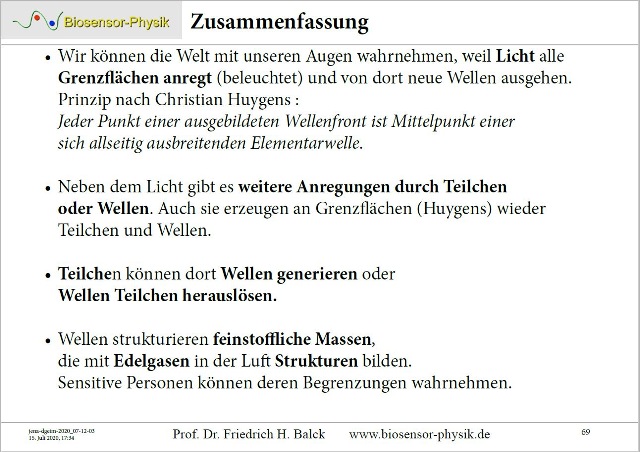 |
|
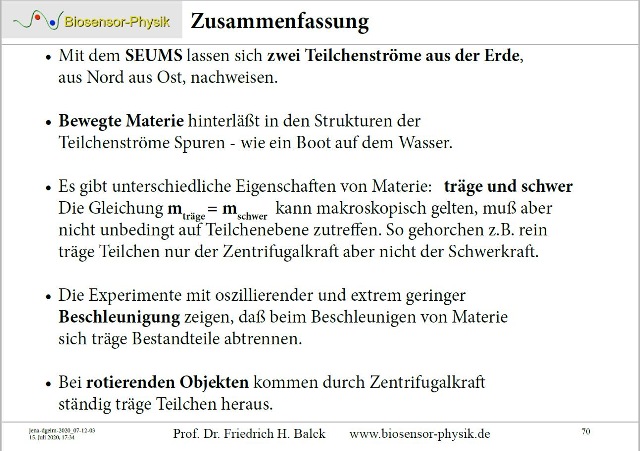 |
|
 |
|
 |
| Abb. 01: Meßkreis (Radius 3,5 m) mit Skalen für Temperatur, Magnetfeld, Gleichspannung und Gleichstrom. Der Detektor ist ein Aluminiumblech. Es steht senkrecht im Mittelpunkt des Kreises. Die obere Kante vom Blech ist exakt N-S ausgerichtet. Bei Anregung durch ein entsprechendes Objekt von der Seite verbreitert sich die spürbare Struktur zwischen den beiden gelben Linien symmetrisch zur Mitte. Der Öffnungswinkel ist ein Maß für die Stärke der Anregung. Measuring circle (radius 3.5 m) with scales for temperature, magnetic field, DC voltage and DC current. The detector is an aluminum sheet. It stands vertically in the center of the circle. The upper edge of the sheet is aligned exactly N-S. When excited by a corresponding object from the side, the perceptible structure between the two yellow lines widens symmetrically to the center. The opening angle is a measure of the strength of the excitation. seums.htm#kapitel-01 (FB) |
 |
| Abb. 02: Meßdaten für die ermittelten Skalen. (in engen Bereichen annähernd linear) x-Achse: Temperatur / °, Gleichstrom durch Diode / µA, Anzahl der Magnetscheiben, Gleichpannung / V Y-Achse: Winkel am Meßkreis (Radius = 3.5 m), Gleichstrom: symmetrisch zur Mittelachse N-S seums.htm#kapitel-02 Measurement data for the determined scales. (approximately linear in narrow ranges) x-axis: temperature / °, direct current through diode / µA, number of magnetic discs, DC voltage / V Y-axis: angle at the measuring circle (radius = 3.5 m), direct current: symmetrical to the center axis N-S (FB) |
 |
| Abb. 03: Das Prinzip Aus Norden kommt eine "Strömung" (grün). In der Mitte wirkt ein Blech (rot) als Detektor. Dahinter in Richtung Süden gibt es in einem Winkelbereich (gelb) eine spürbare Struktur. links: Steht der Detektor exakt N-S, dann ist die gelbe Struktur schmal. Schon bei Fehlstellung von wenigen Grad vergrößert sich dieser Winkelbereich. rechts: Bei zusätzlicher Anregung gibt es weitere Elemente links und rechts von der bisherigen Struktur (sie erweitert sich) - wie bei einer Kerzenflamme im elektrischen Feld. Nähere Einzelzeiten Einzelheiten dazu in Abb. 10 details . Über den Abstand zwischen dem Störer und dem Detektor läßt sich dessen Empfindlichkeit verändern. The principle A "current" (green) comes from the north. In the center, a plate (red) acts as a detector. Behind it to the south, there is a noticeable structure in an angular area (yellow). left: If the detector is exactly N-S, the yellow structure is narrow. Even with a misalignment of a few degrees, this angular area increases. right: With additional excitation, there are more elements to the left and right of the previous structure (it widens) - like a candle flame in an electric field. More details details are given in Fig. 10 The sensitivity of the detector can be changed by the distance between the interferer and the detector. For comparative investigations, it is recommended to set the distance so that the aperture angle remains the same. This value is then the measured variable obtained. (FB) |
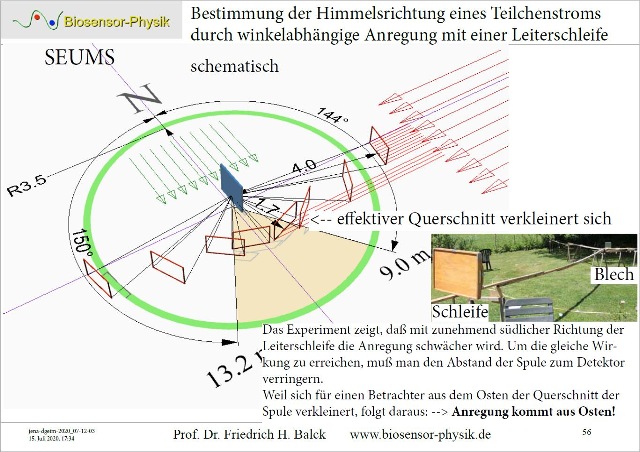 |
| Abb. 04: Auch aus Osten gibt es eine ständige Anregung. Diese aktiviert eine Leiterschleife, deren Einwirkung auf den Detektor winkelabhängig und bei Ausrichtung nach Osten maximal ist. Sie wirkt wie eine Peilantenne. There is also a constant excitation from the east. This activates a conductor loop whose effect on the detector depends on the angle and is maximum when aligned to the east. It acts like a direction finding antenna. aus seums-drei.htm |
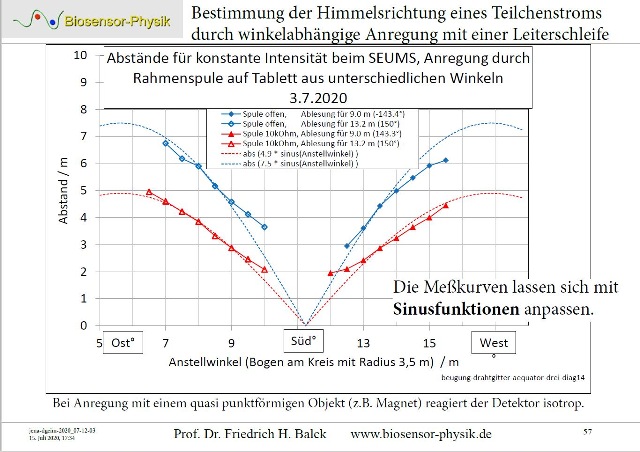 |
| Abb. 05: Wirkung wie bei einer Peilantenne. Bogenlängen für West: (270°) 16,95 m, Süd: (180°) 11,2 m, Ost: (90°) 5,65 m |
 |
| Abb. 06: Abschirmung mit einem Filter. So läßt sich
durch selektives Ausschalten bestimmen, daß die natürlichen Anregungen
aus den Richtungen Nord und Ost kommen. Shielding with a filter. Thus it can be determined by selective switching off that the natural excitations come from the directions north and east. aus seums-drei.htm |
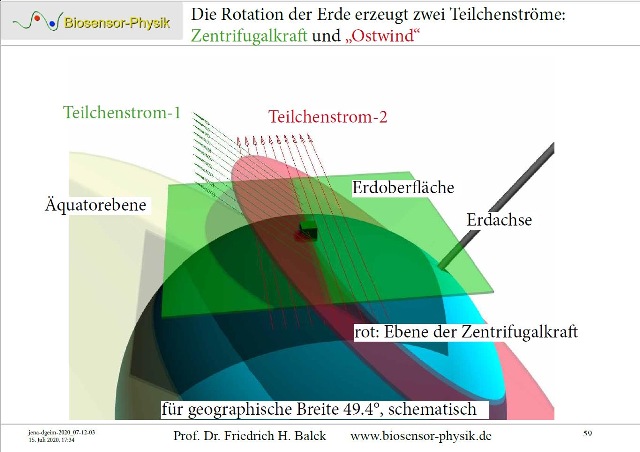 |
| Abb. 07: Die Richtungen der beiden natürlichen Anregungen für die geographischen Breite: 49.4° rote Pfeile: Teilchenstrom-2 von Ost nach West grüne Pfeile: Teilchenstrom-1 senkrecht zur Erdachse rote Scheibe: Ebene der Zentrifugalkraft grüne Fläche: Ebene der Erdoberfläche The rotation of the earth generates two particle currents: centrifugal force and "east wind". The directions of the two natural excitations for latitude: 49.4°. red arrows: Partial current-2 from east to west green arrows: Particle stream-1 perpendicular to the Earth's axis red disk: plane of centrifugal force green plane: plane of the earth's surface (FB) |
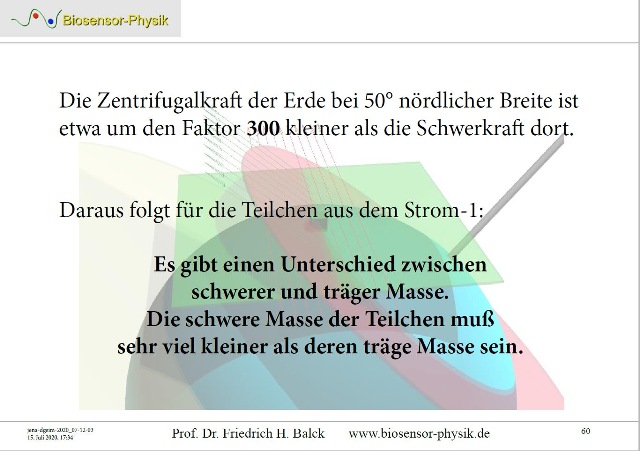 |
| Abb.
08: Die Zentrifugalkraft der Erde bei 50° nördlicher Breite ist
etwa um den Faktor 300 kleiner als die Schwerkraft dort. Daraus folgt für die Teilechen aus dem Strom-1: Es gibt einen Unterschied zwischen schwerer und träger Masse. Die schwere Masse der Teilchen muß sehr viel kleiner als deren träge Masse sein. The centrifugal force of the earth at 50° northern latitude is about a factor of 300 smaller than the gravity there. From this follows for the particles from the current-1: There is a difference between heavy and inertial mass. The heavy mass of the particles must be very much smaller than their inert mass. |
Weitere Details der Struktur 22.07.2020
 |
| Abb. 08: mechanisches Beispiel (schematisch), Blick von oben Eine Ballwurfmaschine schleudert Bälle in dem grünen Sektor von links nach rechts. Sie werden an einer Wand reflektiert und fliegen danach in dem blauen Sektor weiter. Wenn dabei von links (im Bild oben) ein Wind wirkt, werden sie nach rechts (im Bild unten) verweht.
Mechanical example (schematic), view from above. A ball-throwing machine hurls balls from left to right in the green sector. They are reflected by a wall and continue to fly in the blue sector. If there is a wind from the left (in the picture above), they are blown to the right (in the picture below). The greater the distance to the wall, the smaller the speed of the balls, the stronger the wind, the more the direction of flight of the balls changes (FB) |
 |
| Abb. 10: A
B
C
D einfacher Anreger von links (orange). oben: Die Keulen vom Anreger (grün) werden durch einen "Wind" aus Norden nach Süden abgelenkt. A starker Anreger, bzw. kein "Wind", D schwacher Anreger bzw. starker "Wind". Unten: SEUMS mit Detektor. Die vom Detektor beschriebene Ebene wirkt wie eine halbdurchlässige Spiegelwand. Mit gelben Streifen sind die Richtung der reflektierten blauen "Strahlen" und der grünen verlängert bis sie den Meßkreis schneiden. Die vier Versionen unterscheiden sich in der Stärke des Anregers (A stark, D schwach) Diese läßt sich über den Winkel am Meßkreis ermitteln. Der südlichste Rand des gelben Streifens entspricht den Rändern der Strukturen in Abb. 3, 4 und 6. (z.B. 13.2 m) simple exciter from the left (orange). above: The lobes from the exciter (green) are deflected by a "wind" from north to south. A strong exciter or no "wind", D weak exciter or strong "wind". Below: SEUMS with detector. The plane described by the detector acts like a semi-transparent mirror wall. Yellow stripes indicate the direction of the reflected blue "rays" and the green ones are extended until they intersect the measuring circle. The four versions differ in the strength of the exciter (A strong, D weak). This can be determined by the angle at the measuring circle. The southernmost edge of the yellow stripe corresponds to the edges of the structures in Figs. 3, 4 and 6. (e.g. 13.2 m) (FB) |
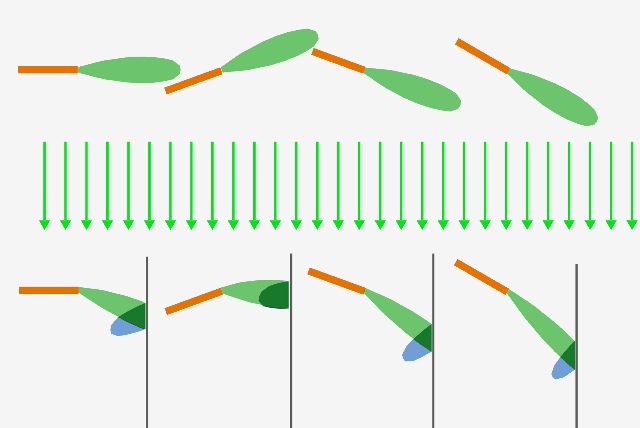 |
| Abb. 11: A
B
C
D Vorhalt beim Zielen (wie beim Schießen auf bewegte Ziele): obere Reihe ohne "Wind", untere Reihe mit "Wind" und Spiegelebene Der kürzeste Weg und die größte Intensität ist bei B. Aiming lead (as when shooting at moving targets): upper row without "wind", lower row with "wind" and mirror plane. The shortest path and the greatest intensity is at B. (FB) |
Vorarbeiten von Ludwig Straniak
 |
| Abb. xx: sechs unterscheidbare Richtungen: Ost West Nord Süd Hoch Tief Die achte Gross-Kraft der Natur , Ludwig Straniak /straniak 1936/ Straniak hat herausgefunden: Es gibt Substanzen (Elemente), die Strahlungen nicht in aus jeder Richtung durchlassen. Damit sind sie offensichtlich selektiv für den "Ostwind" bzw. für den "Nordwind" six distinguishable directions: East West North South High Low The eighth great force of nature , Ludwig Straniak /straniak 1936/ Straniak has found out: There are substances (elements) which do not transmit radiations in from each direction. Thus they are obviously selective for the "east wind" or for the "north wind". fransen.htm#kapitel-005-03 |
Literatur: b-literatur.htm
 |
www.biosensor-physik.de | (c) 08.07.2020 - 17.04.2023 F.Balck |
© BioSensor-Physik 2023
· Impressum
